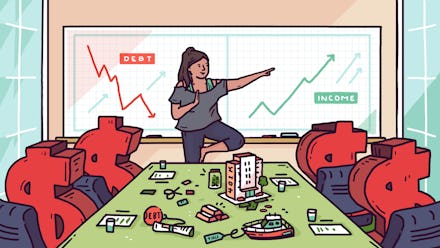Planning for your financial future like a CFO

At any given company, the chief financial officer (CFO) is responsible for overseeing a company’s financial activities and operations. Even if you aren’t the CFO at your company, you’re still the CFO of your personal finances. After all, you are solely responsible for making sure your own financial activities are working in alignment with your short- and long-term goals.
Varshini Kumar, a marketing strategy consultant in Chicago, wants to build on the financial foundation she worked hard to lay down with the ambitious goal of potentially retiring early. Tonya Rapley, founder of My Fab Finance, gave her a lesson on how to be the boss of her own finances to achieve her goal.

Although there are countless personal finance self-help books, we aren’t exactly handed a comprehensive manual when we graduate into adulthood. There are two things to keep in mind as you assess your performance as the CFO of your own life.
Minimize unnecessary debt
As long as you have debt, your money is not entirely yours. There are various ways that people get into debt, whether due to emergencies or living beyond their means. As you begin to plan for your financial future or a big transition, you should minimize any debt, especially unnecessary debt. A couple prime examples of debt to avoid are consumer credit card charges for non-emergencies and loans taken out for frivolous purchases.
To prevent unnecessary debt in the future, ask yourself the following questions before taking out any new debt:
• Is this something that I could pay cash for?
Grow your money
It’s one thing to save money, but it’s another thing to make your money work for you. When you invest, that’s exactly what you’re doing. Sufficient savings are important to ensuring that you aren’t at risk of creating emergency-related debt, and once you save enough, you should consider putting money into investment accounts.
The easiest way to get started with investing is through your workplace retirement program. Depending on your employer, this could be a 401(k), Thrift Savings Plan (TSP), 403(b) or 457. Your eligibility for these programs varies by employer, and some require you to work full-time and/or for a certain amount of time before you can participate. One major perk of utilizing your workplace retirement plan is the convenience, since your contribution is often automatically deducted from your paycheck.
Some companies will even match your contribution. For example, with an employer match, if you contribute 3% of your salary to your retirement plan, your employer would also contribute 3%. If your employer does not have a workplace retirement plan, there are personal alternatives available to help save for retirement.
If you have debt, should you invest?
The honest answer is that it depends on your current financial situation and how much debt you have. The rate of return on most workplace retirement programs (typically between 7% and 11%) is significantly less than interest accrued on most consumer debt. For example, if your 401(k) rate of return is 8% but your credit card debt yields 15% interest or more, having debt is costing you more money than investing can earn you. Weigh out your options. If you can manage both investing and paying off your debt, then it is highly suggested you do so.
Once you have invested in your workplace retirement program, leave your money there to grow. Your retirement fund is not an additional savings account, and you are subject to penalties if you withdraw money for reasons that do not fall under the tax penalty exceptions.
If you leave your employer, you might be given the option to “rollover” into a new plan or cash out your existing contributions. If you do cash out, you’ll be penalized for making an early deduction and forgo the opportunity to accumulate additional returns on your money.
Take the first step
Being the boss of your own money and planning for the future can often feel daunting, but refocusing and laying out your financial goals will start you off in the right direction. Once you’re on the path to success, the road gets a little less bumpy, and soon enough, you’re on cruise control.